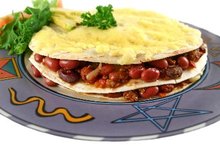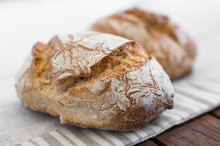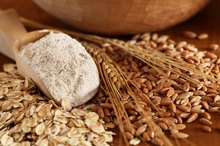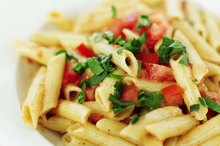The Nutrition Facts for Gluten Free Bread
If you've been diagnosed with celiac disease, you may think that you have to kiss bread goodbye. No more sandwiches, no more toast, no more bread stuffing at Thanksgiving. People with celiac disease cannot eat foods that contain gluten, which is a protein found in all foods made with wheat, rye and barley. And while you can't eat your usual wheat or rye bread anymore, there are a number of gluten-free bread alternatives you can eat instead. The nutritional makeup of gluten-free bread varies depending on the type and brand, but knowing the nutrition information can help you figure out which one makes the best fit for your diet.
Calories Vary From Slice to Slice
Whether you like whole grain or a specific brand, the number of calories in a slice of gluten-free bread varies. One slice contains as little as 65 calories or as much as 100 calories. By comparison, one slice of whole wheat bread typically contains about 80 calories. If you're concerned about calories and weight, you may need to shop around until you find a brand that fits your calorie needs.
Carbs and Fiber
Nutritional Facts for Oatcakes
Learn More
Most of the calories in gluten-free bread come from its carbohydrate content. Like calories, the carbohydrate content of gluten-free bread also varies, ranging from 11 to 21 grams a slice. The fiber content also varies, ranging from 0.5 to 2 grams per slice. Getting more fiber in your diet lowers blood cholesterol and your risk of heart disease and obesity. For better health, look for gluten-free breads that provide more fiber.
Protein and Fat
The protein and fat content in gluten-free bread does not vary from brand to brand. One slice contains 2 grams of protein and 2 grams of fat. Although the differences are slight, it's interesting to note that gluten-free bread is a little higher in fat and lower in protein than gluten-containing bread, which has 3 grams of protein and 1 gram of fat in one slice. Both protein and fat are essential nutrients you need for good health. Protein in food is important for tissue repair and immune health, while fat provides energy and helps you absorb fat-soluble vitamins.
Sodium Range
Are Whole-Wheat Tortillas Healthy?
Learn More
You might not think of bread as being a salty food, but all the gluten-free breads contain some amount of sodium. The amount varies depending on brand and type, ranging from 120 to 150 milligrams per slice. By comparison, one slice of whole wheat bread contains 145 milligrams of sodium. Getting too much sodium in your diet increases your risk of high blood pressure, and it is recommended that you limit your intake to 2,300 milligrams a day, or 1,500 milligrams if you already have high blood pressure.
Modicum of Minerals
Some gluten-free breads provide a small amount of iron and calcium, meeting up to 4 percent of the daily value for iron and up to 1 percent of the daily value for calcium per slice. Iron helps make hemoglobin and assists with carrying oxygen throughout your body. Adequate intake of calcium helps keep your teeth and bones healthy and strong.
Related Articles
References
Writer Bio
Jill Corleone is a registered dietitian and health coach who has been writing and lecturing on diet and health for more than 15 years. Her work has been featured on the Huffington Post, Diabetes Self-Management and in the book "Noninvasive Mechanical Ventilation," edited by John R. Bach, M.D. Corleone holds a Bachelor of Science in nutrition.









